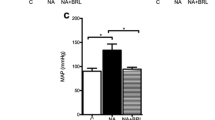Abstract
In adult rat ventricular cardiomyocytes α1-adrenoceptor (AR) stimulation causes increases in protein synthesis. On the other hand β1-AR stimulation inhibits protein synthesis, and evokes apoptotic cell death. We studied, in adult rat ventricular cardiomyocytes, effects of noradrenaline (NA), adrenaline (ADR) and phenylephrine (PE) on protein synthesis (assessed by [3H]-phenylalanine incorporation into the cardiomyocytes) in relation to effects on early apoptosis (measured by Annexin V/propidium iodide staining). PE (10−9–10−5 M) induced protein synthesis was not affected by the β1-AR blocker CGP 20712A (CGP, 300 nM) or β2-AR blocker ICI 118,551 (ICI, 55 nM). ADR (10−9–10−5 M) induced protein synthesis was enhanced by CGP and decreased by ICI. Pretreatment of the cardiomyocytes with pertussis toxin (PTX) decreased NA- and ADR- induced protein synthesis, but did not affect PE-effects. NA (10−5 M) and ADR (10−5 M) caused a significant increase in the number of apoptotic cells; these effects were enhanced by PTX-treatment, abolished by CGP, but not significantly affected by ICI. Furthermore, there was a significant negative correlation between catecholamine-evoked apoptosis and catecholamine-induced hypertrophic effects. We conclude that, in ventricular cardiomyocytes of adult rats, growth-promoting effects of NA and ADR are composed of α1A-AR mediated increase in protein synthesis and β1-AR mediated apoptosis that counteracts increases in protein synthesis. The role of β2-adrenoceptor appears to be a balance of antiapoptotic effects via a PTX-sensitive pathway and proapoptotic effects via a GS-adenylyl cyclase pathway.









Similar content being viewed by others
References
Autelitano DJ, Woodcock EA (1998) Selective activation of α1A-adrenergic receptors in neonatal cardiac myocytes is sufficient to cause hypertrophy and differential regulation of α1-adrenergic receptor subtype mRNAs. J Mol Cell Cardiol 20:1515–1523
Benfey BG (1990) Function of myocardial alpha-adrenoceptors. Life Sci 46:743–757
Brodde O-E, Michel MC (1999) Adrenergic and muscarinic receptors in the human heart. Pharmacol Rev 51:651–690
Chesley A, Lundberg MS, Asai T, Xiao RP, Ohtani S, Lakatta EG, Crow MT (2000) The β2-adrenergic receptor delivers an antiapoptotic signal to cardiac myocytes through G(i)-dependent coupling to phosphatidylinositol 3'-kinase. Circ Res 87:1172–1179
Communal C, Singh K, Pimentel DR, Colucci WS (1998) Norepinephrine stimulates apoptosis in adult rat ventricular myocytes by activation of the beta-adrenergic pathway. Circulation 98:1329–1334
Communal C, Singh K, Sawyer DB, Colucci WS (1999) Opposing effects of beta(1)- and beta(2)-adrenergic receptors on cardiac myocyte apoptosis: role of a pertussis toxin-sensitive G protein. Circulation 100:2210–2212
Communal C, Colucci WS, Singh K (2000) p38 Mitogen-activated protein kinase pathway protects adult rat ventricular myocytes against β-adrenergic receptor-stimulated apoptosis. J Biol Chem 275:19395–19400
Knowlton KU, Michel MC, Itani M, Shubeita HE, Ishihara K, Brown JH, Chien KR (1993) The α1A-adrenoceptor subtype mediates biochemical, molecular, and morphologic features of cultured myocardial cell hypertrophy. J Biol Chem 268:15374–15380
Lands AM, Arnold A, McAuliff JP, Luduena FP, Brown TG Jr (1967) Differentiation of receptor systems activated by sympathomimetic amines. Nature 214:597–598
Michelotti GA, Price DT, Schwinn DA (2000) Alpha 1-adrenergic receptor regulation: basic science and clinical implications. Pharmacol Ther 88:281–309
Pönicke K, Giessler C, Grapow M, Heinroth-Hoffmann I, Becker K, Osten B, Brodde O-E (2000) FP-receptor mediated trophic effects of prostanoids in rat ventricular cardiomyocytes. Br J Pharmacol 129:1723–1731
Pönicke K, Schlüter K-D, Heinroth-Hoffmann I, Seyfarth T, Goldberg M, Piper HM, Brodde O-E (2001) Noradrenaline-induced increase in protein synthesis is mediated by α1A-adrenoceptors in adult rat cardiomyocytes. Naunyn-Schmiedebergs Arch Pharmacol 364:444–453
Pönicke K, Heinroth-Hoffmann I, Brodde O-E (2002) Differential effects of bucindolol and carvedilol on noradrenaline-induced hypertrophic response in ventricular cardiomyocytes of adult rats. J Pharmacol Exp Ther 301:71–76
Schäfer M, Pönicke K, Heinroth-Hoffmann I, Brodde O-E, Piper HM, Schlüter KD (2001) Beta-adrenoceptor stimulation attenuates the hypertrophic effect of alpha-adrenoceptor stimulation in adult rat ventricular cardiomyocytes. J Am Coll Cardiol 37:300–307
Schlüter K-D, Millar BC, McDermott BJ, Piper HM (1995) Regulation of protein synthesis and degradation in adult ventricular cardiomyocytes. Am J Physiol 269 (Cell Physiol 38):C1347–C1355
Shizukuda Y, Buttrick PM (2002) Subtype specific roles of beta-adrenergic receptors in apoptosis of adult rat ventricular myocytes. J Mol Cell Cardiol 34:823–831
Simpson P (1983) NA-stimulated hypertrophy of cultured rat myocardial cells is an α-adrenergic response. J Clin Invest 72:732–738
Steinberg SF (1999) The molecular basis for distinct β-adrenergic receptor subtype actions in cardiomyocytes. Circ Res 85:1101–1111
Steinberg SF (2000) The cellular actions of β-adrenergic receptor agonists: looking beyond cAMP. Circ Res 8:1079–1082
Vermes I, Haanen C, Steffens-Nakken H, Reutelingsperger C (1995) A novel assay for apoptosis. Flow cytometric detection of phosphatidylserine expression on early apoptotic cells using fluorescein labelled Annexin V. J Immunol Methods 184:39–51
Xiao RP (2001) Beta-adrenergic signaling in the heart: dual coupling of the β2-adrenergic receptor to G(s) and G(i) proteins. Sci STKE 104:RE15
Zaugg M, Xu W, Lucchinetti E, Shaiyiq SA, Jamali NZ, Siddiqui MAQ (2000) β-adrenergic receptor subtypes differentially affect apoptosis in adult rat ventricular myocytes. Circulation 102:344–350
Zhu WZ, Zheng M, Koch WJ, Lefkowitz RJ, Kobilka BK, Xiao RP (2001) Dual modulation of cell survival and cell death by beta(2)-adrenergic signaling in adult mouse cardiac myocytes. Proc Natl Acad Sci USA 98:1607–1612
Zimmer HG (1997) Catecholamine-induced cardiac hypertrophy: significance of proto-oncogene expression. J Mol Med 75:849–859
Acknowledgements
The skilful technical assistance of I. Adler, A. Hauser, A. Dunemann and M. Niebisch is gratefully acknowledged. This work was supported by a grant of the Deutsche Forschungsgemeinschaft Bonn/Germany (SFB TR 2–01 to O.-E.B.). The authors are thankful to Ciba-Geigy for generous gift of CGP 20712A.
Author information
Authors and Affiliations
Corresponding author
Rights and permissions
About this article
Cite this article
Pönicke, K., Heinroth-Hoffmann, I. & Brodde, OE. Role of β1- and β2-adrenoceptors in hypertrophic and apoptotic effects of noradrenaline and adrenaline in adult rat ventricular cardiomyocytes. Naunyn-Schmiedeberg's Arch Pharmacol 367, 592–599 (2003). https://doi.org/10.1007/s00210-003-0754-z
Received:
Accepted:
Published:
Issue Date:
DOI: https://doi.org/10.1007/s00210-003-0754-z



